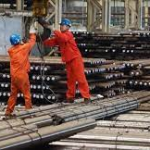 Chinese steel futures prices have reached all-time highs lately, driven by bullish expectations for demand and the likelihood that steel production restrictions will remain in place throughout the year. The resulting rise in steel prices has bolstered the profits of steel mills that produce steel.
Chinese steel futures prices have reached all-time highs lately, driven by bullish expectations for demand and the likelihood that steel production restrictions will remain in place throughout the year. The resulting rise in steel prices has bolstered the profits of steel mills that produce steel.
The most traded contract on the Shanghai Futures Exchange (SHFE) for May delivery touched 5,017 Yuan/ton ($764.1/ton) on March 29, a new high since May 2011, before closing at 4,964 Yuan/ton at the end of the March 30 trading session.
The most traded contract on hot-rolled coils, also with May delivery, closed at 5,372 yuan/ton on March 30, after briefly touching 5,408 yuan/ton on the same day, the highest since 2014, when SHFE first launched HRC futures.
The unwavering optimism about the steel market from the most bullish traders was confirmed by the evidence of strengthening demand.
On the other hand, the rise in steel prices also followed the imposition of steel production limits during the past month, and the confirmation that steel mills in the Tangshan production hub in northern China will have to continue limiting production for the rest of the year.
The period when the toughest restrictions were in place has passed, and steel production will rebound in the short term. But the room for this increase in production is limited, because long-term restrictions will continue to limit production.
The Tangshan government issued a notice on March 19 demanding that all but two of the 24 BF steel producers under the city’s jurisdiction reduce their production from March 20 to December 31 from 30% to 50% to help reduce air pollution.
The rapid increase in prices that followed this news has seen steel mills’ profit margins increase.
Actual profits are currently not at 2018 levels because raw material prices are much higher. However, high finished steel prices, as well as steel mill profits, may not last.
There is still room for steel prices to rise, but the space is limited. Demand for steel is firm, which will drive up prices, but you have to think about whether end users of steel will be able to accept such high prices.
Increases in raw materials will sooner or later be reflected in steel-intensive products, and when these can no longer be supported by users, prices will have to flex.
Over the past two years, Beijing’s supply-side reforms have spurred increased profits for steel mills, especially in 2018. We have seen steel mills increase their steel production to maximize profits, while the increased production has also intensified raw material prices.
The Chinese government’s determination to curb steel production in 2021, along with its long-term goal of reducing carbon emissions, could see China reach peak steel capacity utilization.
.gif) Loading
Loading

